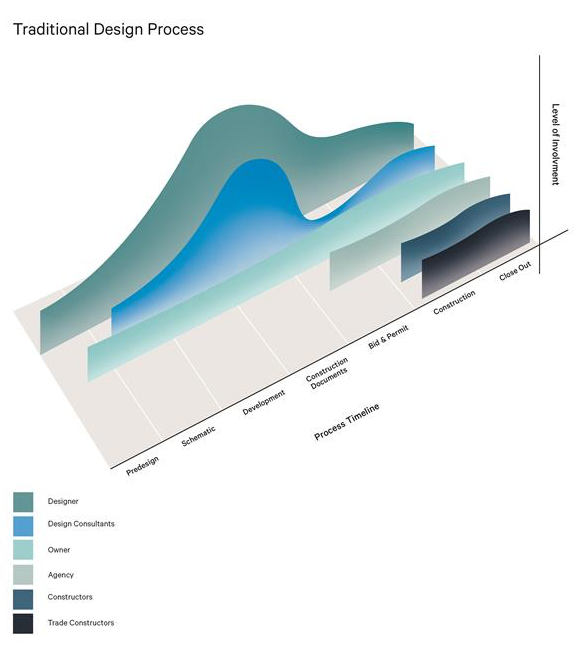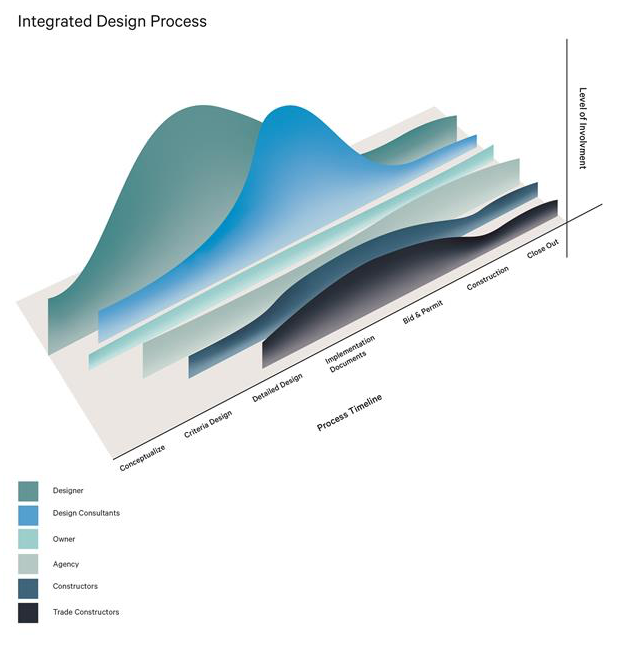Member Insights by Shyft Collective
In design and construction projects, the delivery model determines how teams work together. While there is no one-size-fits-all solution, SHYFT believes our Integrated Project Delivery Plus (IPD+) model is best suited for projects and clients requiring or wanting ultimate team collaboration. Pause to think about issues you have seen or heard when working on a multi-faceted project. In full transparency, our experience says it is most often incompatible, adversarial relationships, unclear expectations, or role and responsibility confusions that create project chaos. In our design and construction world, this often means multiple revisions, continuous finger-pointing, poor productivity, and a lack of communication resulting in delayed schedules, increased costs, and even a lack of quality.
The SHYFT IPD+ model integrates the full project team of architects, project managers, real estate finance managers, real estate brokers, and construction managers, working through a SHYFT owner’s representative. An “Owner’s Rep” acts as a trusted advisor to the client by leveraging the knowledge of all team members to define and improve the project outcome. She/he works on behalf of the owner to conduct everyone working together in the best interest of the client, the overall project, and the success of the client’s organization.
Now, you might be wondering: How are integrated projects different from traditional delivery models?
Traditional Projects vs Integrated Projects
Key differences are visually depicted in the graphs below. These graphs represent the amount and duration of involvement of key project participants throughout different phases of the project for both Integrated and Traditional projects. During Integrated projects, the project flow from conceptualization through implementation and closeout differs significantly from the traditional model. During an integrated project, the design decisions are moved upstream as far as possible, where changes are more effective and less costly. This requires a total re-thinking of traditional project phases and terminology.
In addition to shifting design decision-making forward, the redefinition of phases is driven by two key concepts. The first is the integration of early input from trade contractors, installers, fabricators, suppliers, and designers. The second is the ability to model and simulate the project more accurately using BIM (Building Information Modeling) tools. These two concepts enable the design to be at a greater level of completion prior to the beginning of the documentation phase. Thus, the first three phases of the integrated project – Conceptualization, Criteria Design, and Detailed Design – involve more effort than their traditional model counterparts.
An increased level of completion in earlier project stages means Implementation Documents require less effort than the traditional Construction Documents phase, and the early participation of regulatory agencies, trade contractors, and fabricators allows shortening of the Bid/Permit and Construction phases. The planned result is that the project is defined and coordinated to a further level prior to construction, enabling a more efficient Construction phase and a potentially shorter build period.
Keys to Success
You might be wondering: What are some keys to success when working on an Integrated Project? One word: Communication. Beth Benzenberg, a Senior Interior Designer at SHYFT, states “Communication is key.Everyone needs to be fully aware of the process and each team member’s responsibilities”. IPD’s focus on team performance is based upon open, direct, and honest communication among all participants. Responsibilities must be clearly defined in a no-blame culture leading to identification and resolution of problems. Disputes are recognized as they occur and promptly resolved.
From a construction perspective, Kelly Nelson, Senior Construction Manager at SHYFT, states that “It is important that the construction team be involved early on to understand the client’s specific goals and expectations. Understanding the vision becomes important when interpreting drawings and executing various finish details. Another advantage of involving the construction team early on is to help reduce unnecessary costs, provide value analysis/engineering, and help coordinate the various MEP and structural components to ensure a smooth construction schedule and avoid delays”.
Alisha King, a Project Manager at SHYFT Collective, gives her opinion from a Project Manager/Owner’s Rep Perspective – “As the PM/OR, I really am responsible for driving the project the entire way from start to finish and ensuring the team members throughout the process are engaged and responsive. Identifying the project constraints upfront is key to setting the stage for success. Additionally, making sure all teams are involved in reviewing and updating the project schedule is important before any significant work begins.”
Value-Add to Client using the SHYFT IPD+ Model
At SHYFT, our team continues to gain valuable experience working on fully integrated projects. The first-hand, positive results and value-add to clients are more easily shared from person-to-person and project-to-project. Regarding IPD value, Kelly adds, “Construction projects can be extremely stressful and time-consuming. Having one organization guide a client throughout the entire project can help simplify the process and eliminate potential conflicts and finger-pointing between entities. With SHYFT handling the entire project from start to finish, it provides clear and immediate accountability. Having team members work together and in closer proximity can provide significant efficiencies with regards to the flow of information. And finally, decision-making is streamlined, resulting in tighter schedules and quicker project turnaround.”
From a design perspective, Beth shares, “Depending on the size of the project, you may have one team member with multiple roles and wearing many hats, but they always have colleagues in-house to bounce things off of. This expertise ensures that we are constantly evaluating decisions internally from a 360-degree perspective and from many angles. This allows the client and owner’s rep to be more informed and for design decisions to be made quickly.”
Unlike a typical Integrated project, IPD+ introduces an owner’s representative into the project structure to help ensure all scopes of work are considered from an owner’s perspective and properly coordinated with the rest of the project team/contractors. IPD+ is the highest form of collaboration because all three primary parties (Owner, Architect, Contractor) are aligned from day one. Instead of the client sourcing individual services, the IPD+ team handles strategic planning, conceptual design, project planning, architectural design and consultant coordination, and construction oversight from concept to completion. While the IPD+ team may consist of many individuals across various disciplines, it is led by an owner’s rep from our team. The inclusion of SHYFT’s Owner’s Rep allows the owner or owner’s designated liaison to focus on their daily work, reducing the client’s project-related activity to the high-level direction and final decision-making. The SHYFT owner’s rep then takes on most of the day-to-day owner roles and responsibilities as it relates to the project.
Additional efficiencies gained when moving to IPD+, specific to the owner’s representative role include:
- + The owner has a main point of contact throughout the duration of a project
- + The owner’s rep acts as the lead coordinator with the clients’ in-house resources involved on a project – IT, Communications, HR, Legal, Facilities, etc.
- + Project decisions consistently evaluated from an owner’s perspective, ensuring overarching project goals/objectives are being met
- + Ensures the design of separate scope packages (FF&E, AV, network/technology, prefab product, graphics/wayfinding, etc.) are integrated with overall architectural and interior design
- + All non-construction related scopes (FF&E, AV, network/technology, prefab product, graphics/wayfinding, move planning, etc.) in conjunction with build-out activities.
- + Maintain master project budget/schedule inclusive of all scopes
- + General oversight for all scopes of work during execution phase
Is IPD+ a perfect one-size-fits-all project solution? Of course it’s not! Every project is different and comes with its own unique set of risks and challenges. The main difference between SHYFT IPD+ and more-traditional models is that if a challenge or problem does arise, SHYFT will OWN it and make it right!

